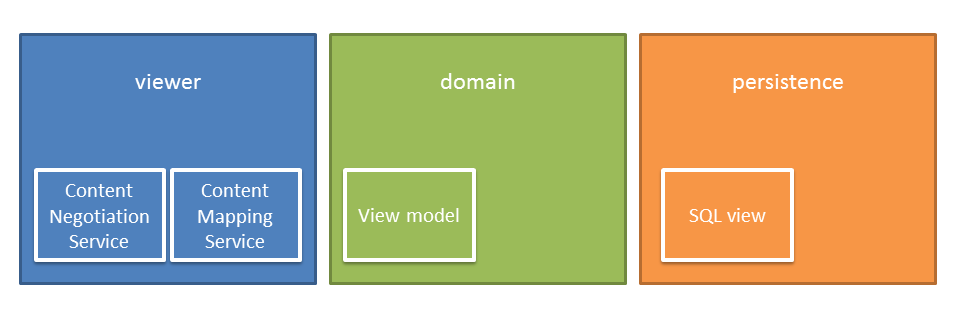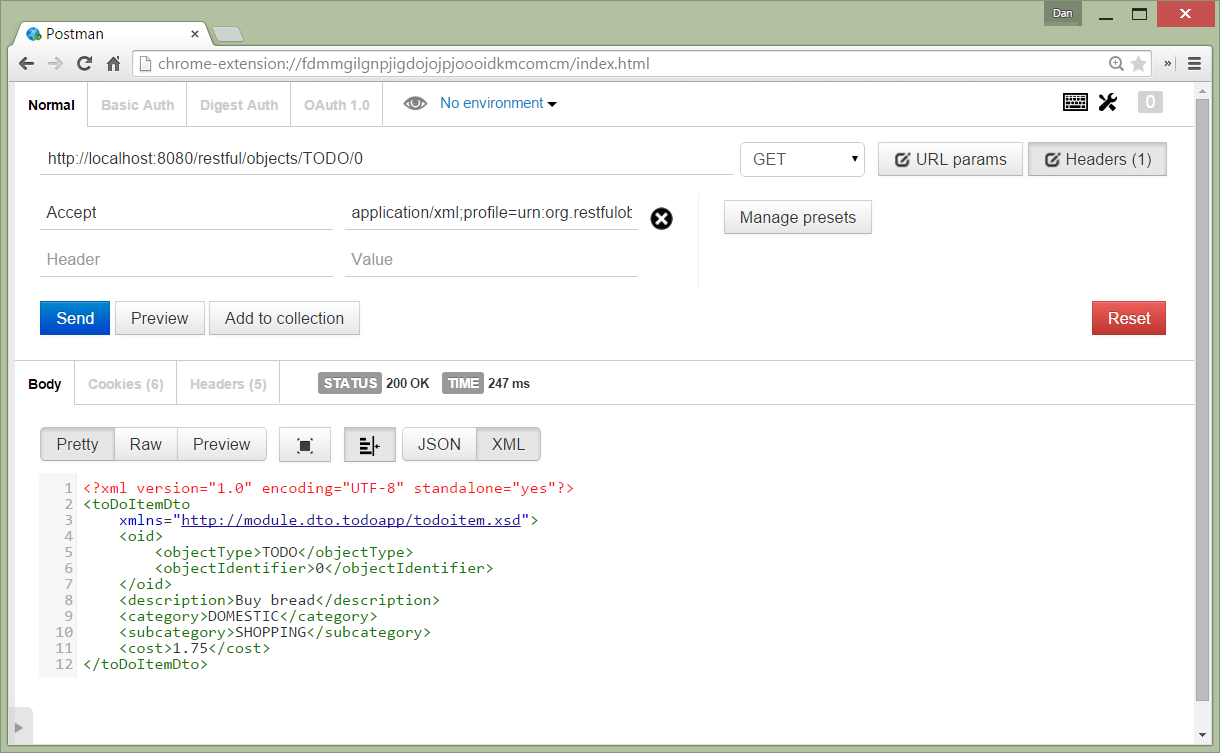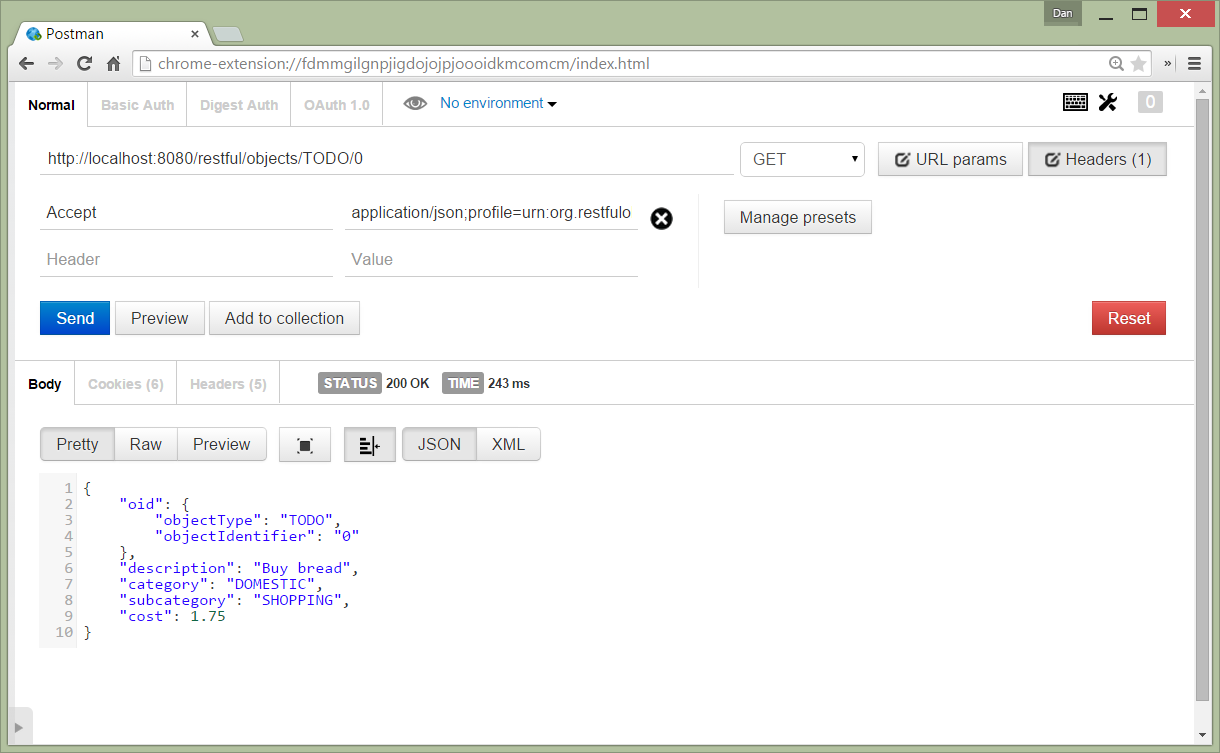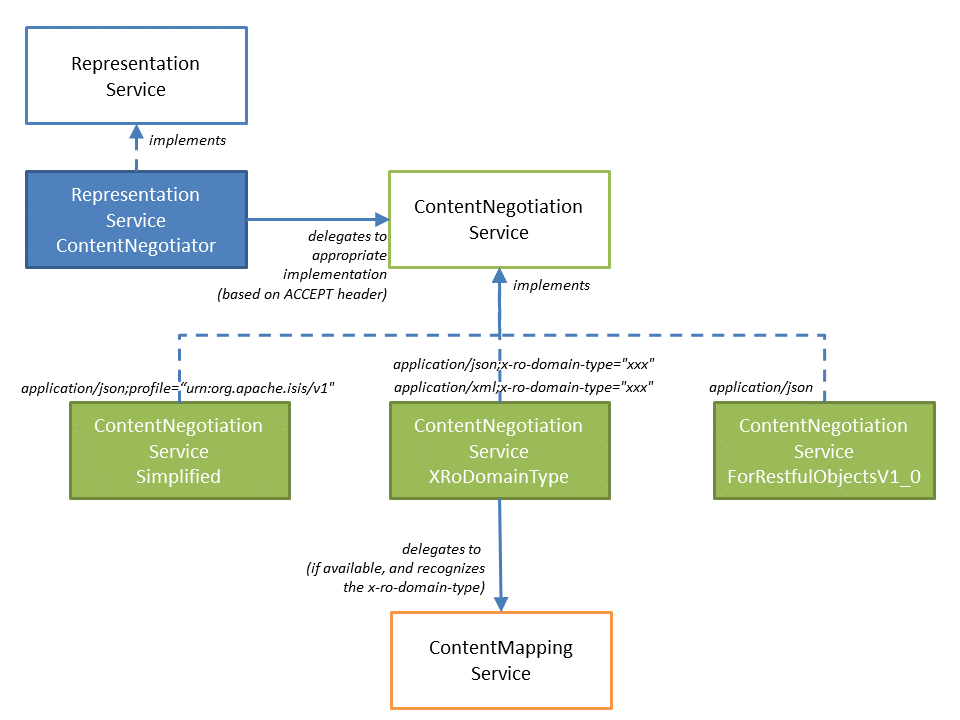

Framework Internal Services
1. Framework Internal Services
This guide documents a number of domain services that are not part of the framework’s formal API, they use classes that are outside of the applib. They should be thought of as part of the internal design of the framework, and are liable to change from release to release.
|
We do not guarantee that semantic versioning will be honoured for these services. |
1.1. Other Guides
Apache Isis documentation is broken out into a number of user, reference and "supporting procedures" guides.
The user guides available are:
The reference guides are:
The remaining guides are:
-
Developers' Guide (how to set up a development environment for Apache Isis and contribute back to the project)
-
Committers' Guide (release procedures and related practices)
2. Presentation Layer
These domain services are internal to the framework, controlling various aspects of the presentation layer.
The table below summarizes the presentation layer internal SPIs defined by Apache Isis. It also lists their corresponding implementation, either a default implementation provided by Apache Isis itself, or provided by one of the (non-ASF) Incode Platform modules.
| SPI | Maven Module Impl’n (g: a:) |
Implementation | Notes |
|---|---|---|---|
|
Encodes the algorithm that delegates to any registered |
|
|
Generates the representations, delegating to any registered |
|
Key:
-
o.a.iis an abbreviation fororg.apache.isis -
o.ia.mis an abbreviation fororg.isisaddons.module -
o.a.i.c.m.sis an abbreviation fororg.apache.isis.core.metamodel.services -
o.a.i.c.r.sis an abbreviation fororg.apache.isis.core.runtime.services -
o.a.i.v.rois an abbreviation fororg.apache.isis.viewer.restfulobjects
2.1. ContentNegotiationService
The ContentNegotiationService is a plug-in point for the RestfulObjects viewer so that it can generate representations according to HTTP Accept header of the request. This idea is discussed in section 34.1 of the Restful Objects spec v1.0.
The principal motivation is to allow more flexible representations to be generated for REST clients that (perhaps through their use of a certain Javascript library, say) expect, or at least works best with, a certain style of representation.
Another use case is to support "third party" REST clients over which you have no control. In this scenario you must not naively expose entities through the RO viewer, because over time those entities will inevitably evolve and change their structure. If the entities were exposed directly then those REST clients will break.
Instead you need to create some sort of stable facade over your domain entities, one which you will preserve even if the domain entities change. There are three ways in which you can do this:
-
first is to solve the problem at the domain layer by defining a regular Apache Isis view model. This is then surfaced over the RO viewer.
If the underlying entities change, then care must be taken to ensure that structure of the view model nevertheless is unchanged.
-
a second option is to solve the problem at the persistence layer, but defining a (SQL) view in the database and then mapping this to a (read-only) entity. Again this is surfaced by the RO viewer.
If the underlying tables change (as the result of a change in their corresponding domain entities) then once more the view must be refactored so that it still presents the same structure.
-
our third option is to solve the problem at the presentation layer, using the
ContentNegotiationServicedescribed in this section.The
ContentNegotiationServiceis responsible for inspecting the HTTPAcceptheader, and use this to select the correct representation to render.The Apache Isis framework provides three implementations of
ContentNegotiationServicewhich inspects different elements of the HTTPAcceptheader. One of these implementations,ContentNegotiationServiceXRoDomainTypewill further delegate down to the companionContentMappingServiceservice (if configured/available), based on the value of the "x-ro-domain-type" parameter of the header.A typical implementation of
ContentMappingServicewill convert the domain object into some sort of DTO (data transfer object) as specified by the "x-ro-domaintype". If this DTO is annotated with JAXB or Jackson mappings, then the RO viewer (courtesy of the underlying RestEasy framework) can serialize these directly.What all that means is that, if the underlying entities change, we are required to update the mappings in the
ContentMappingServiceto map to the same DTOs.
This diagram illustrates the three options available:
2.1.1. SPI
The SPI defined by this service is:
public interface ContentNegotiationService {
Response.ResponseBuilder buildResponse( (1)
RepresentationService.Context2 renderContext2,
ObjectAdapter objectAdapter);
Response.ResponseBuilder buildResponse( (2)
RepresentationService.Context2 renderContext2,
ObjectAndProperty objectAndProperty);
Response.ResponseBuilder buildResponse( (3)
RepresentationService.Context2 renderContext2,
ObjectAndCollection objectAndCollection);
Response.ResponseBuilder buildResponse( (4)
RepresentationService.Context2 renderContext2,
ObjectAndAction objectAndAction);
Response.ResponseBuilder buildResponse( (5)
RepresentationService.Context2 renderContext2,
ObjectAndActionInvocation objectAndActionInvocation);
}| 1 | representation of a single object, as per section 14.4 of the RO spec, v1.0 |
| 2 | representation of a single property of an object, as per section 16.4 of the RO spec v1.0 |
| 3 | representation of a single collection of an object, as per section 17.5 of the RO spec v1.0 |
| 4 | representation of a single action (prompt) of an object, as per section 18.2 of the RO spec v1.0 |
| 5 | representation of the results of a single action invocation, as per section 19.5 of the RO spec v1.0 |
These methods provide:
-
a
RepresentationService.Context2which provides access to request-specific context (eg HTTP headers), session-specific context (eg authentication) and global context (eg configuration settings) -
an object representing the information to be rendered
eg
ObjectAdapter,ObjectAndProperty,ObjectAndCollectionetc
In all cases, returning null will result in the regular RO spec representation being returned.
2.1.2. Implementation
ContentNegotiationServiceAbstract (in o.a.i.v.ro.rendering.service.conneg) provides a no-op implementation of the SPI, along with supporting methods:
public abstract class ContentNegotiationServiceAbstract implements ContentNegotiationService {
...
protected Object objectOf(final ObjectAdapter objectAdapter) { ... }
protected Object returnedObjectOf(ObjectAndActionInvocation objectAndActionInvocation) { ... }
protected Class<?> loadClass(String cls) { ... }
protected void ensureJaxbAnnotated(Class<?> domainType) { ... }
protected void ensureDomainObjectAssignable(
String xRoDomainType, Class<?> domainType, Object domainObject) { ... }
}As discussed in the introduction, the framework also provides three implementation of this service, one of which is o.a.i.v.ro.rendering.service.conneg.ContentNegotiationServiceXRoDomainType. This implementation handles content negotiation for two of the possible representations, object representations and for action result representations:
-
For object representations it will handle requests with HTTP
Acceptheaders of the form:-
application/json;profile=urn:org.restfulobjects:repr-types/object;x-ro-domain-type=… -
application/xml;profile=urn:org.restfulobjects:repr-types/object;x-ro-domain-type=…
-
-
for action result representations it will similarly handle requests with HTTP
Acceptheaders of the form:-
application/json;profile=urn:org.restfulobjects:repr-types/action-result;x-ro-domain-type=… -
application/xml;profile=urn:org.restfulobjects:repr-types/action-result;x-ro-domain-type=…
-
The value of the x-ro-domain-type parameter corresponds to the DTO to be mapped into by the ContentMappingService.
If the DTO is annotated with JAXB, then also note that the runtime type must be annotated with the JAXB javax.xml.bind.annotation.XmlRootElement so that RestEasy is able to unambiguously serialize it.
The other two implementations of ContentNegotiationService are:
-
ContentNegotiationServiceForRestfulObjectsV1_0which returns representations according to the Restful Objects spec.
One extension (specific to Apache Isis, not part of the RO spec) is that actions can also be invoked with an HTTP
Acceptheader of the form:application/json;profile=urn:org.restfulobjects:repr-types/objectIf the action result returns a collection then this will automatically converted to a
DomainObjectListview model. This can be useful for generic viewers. -
ContentNegotiationServiceOrgApacheIsisV1which returns simplified representations
2.1.3. Usage
You can find an example of all these services in the (non-ASF) Isis addons' todoapp. This defines a ToDoItemDto class that is JAXB annotated (it is in fact generated from an XSD).
The example app also includes an implementation of ContentMappingService that maps todoapp.dom.module.todoitem.ToDoItem entities to todoapp.dto.module.todoitem.ToDoItemDto classes.
A REST client can therefore request a DTO representation of an entity by invoking
http://localhost:8080/restful/objects/TODO/0with an Accept header of:
application/xml;profile=urn:org.restfulobjects:repr-types/object;x-ro-domain-type=todoapp.dto.module.todoitem.ToDoItemDtowill result in an XML serialization of that class:
while similarly hitting the same URL with an Accept header of:
application/json;profile=urn:org.restfulobjects:repr-types/object;x-ro-domain-type=todoapp.dto.module.todoitem.ToDoItemDtowill result in the JSON serialization of that class:
Configuration
The default ContentNegotiationServiceXRoDomainType implementation provides a configuration property which controls whether a mapped domain object is pretty-printed (formatted, indented) or not:
isis.services.ContentNegotiationServiceXRoDomainType.prettyPrint=trueIf the property is not set, then the default depends on the deployment type; production mode will disable pretty printing, while prototyping mode will enable it.
2.1.4. Registering the Services
Apache Isis' default implementations of ContentNegotiationService service are automatically registered and injected (it is annotated with @DomainService) so no further configuration is required.
To use an alternative implementation, use @DomainServiceLayout#menuOrder() (as explained in the introduction to this guide).
2.1.5. Related Services
The default implementation of ContentNegotiationService delegates to ContentMappingService (if present) to convert domain entities into a stable form (eg DTO).
The ContentNegotiationService is itself called by the (default implementation of) RepresentationService.
2.2. RepresentationService
The RepresentationService is the main plug-in point for the RestfulObjects viewer to generate representations.
The default implementations generate representations according to the Restful Objects spec v1.0. However, it also delegates to the ContentNegotiationService which provides a mechanism for altering representations according to the HTTP Accept header. This allows more flexible representations to be generated for REST clients that (perhaps through their use of a certain Javascript library, say) expect, or at least works best with, a certain style of representation.
In all there are three domain services that can influence the representations generated: this service, ContentNegotiationServiceand the ContentMappingService. The diagram below shows how these collaborate:
The RepresentationServiceContentNegotiator is the default implementation of the top-level RepresentationService, and it delegates to list of injecting ContentNegotiationService services. Using a chain of responsibility pattern, it returns the first non-null representation. For their part, the implementations of ContentNegotiationService use the HTTP Accept header to determine if they should render any representation or just return null.
2.2.1. SPI
The SPI defined by this service is:
public interface RepresentationService {
Response objectRepresentation( (1)
Context rendererContext,
ObjectAdapter objectAdapter);
Response propertyDetails( (2)
Context rendererContext,
ObjectAndProperty objectAndProperty,
MemberReprMode memberReprMode);
Response collectionDetails( (3)
Context rendererContext,
ObjectAndCollection objectAndCollection,
MemberReprMode memberReprMode);
Response actionPrompt( (4)
Context rendererContext,
ObjectAndAction objectAndAction);
Response actionResult( (5)
Context rendererContext,
ObjectAndActionInvocation objectAndActionInvocation,
ActionResultReprRenderer.SelfLink selfLink);
public static interface Context extends RendererContext {
ObjectAdapterLinkTo getAdapterLinkTo();
}
}| 1 | representation of a single object, eg as per section 14.4 of the RO spec, v1.0 |
| 2 | representation of a single property of an object, eg as per section 16.4 of the RO spec v1.0 |
| 3 | representation of a single collection of an object, eg as per section 17.5 of the RO spec v1.0 |
| 4 | representation of a single action (prompt) of an object, eg as per section 18.2 of the RO spec v1.0 |
| 5 | representation of the results of a single action invocation, eg as per section 19.5 of the RO spec v1.0 |
These methods provide:
-
a
RendererContextwhich provides access to request-specific context (eg HTTP headers), session-specific context (eg authentication) and global context (eg configuration settings) -
an object representing the information to be rendered
eg
ObjectAdapter,ObjectAndProperty,ObjectAndCollectionetc -
for members, whether the representation is in read/write mode
ie
MemberReprMode
2.2.2. Implementation
As discussed in the introduction, the framework provides a default implementation, o.a.i.v.ro.rendering.service.RepresentationServiceContentNegotiator. This delegates to ContentNegotiationService to generate an alternative representation; but if none is provided then it falls back on generating the representations as defined in the Restful Objects spec v1.0.
To use an alternative implementation, use @DomainServiceLayout#menuOrder() (as explained in the introduction to this guide).
2.2.3. Registering the Services
Apache Isis' default implementation of RepresentationService service is automatically registered and injected (it is annotated with @DomainService) so no further configuration is required.
2.2.4. Related Services
The default implementation delegates to ContentNegotiationService, whose default implementation may delegate in turn to ContentMappingService (if present).
3. Application Layer
These domain services are internal to the framework, controlling various aspects of the application layer.
The table below summarizes the application layer internal SPIs defined by Apache Isis. It also lists their corresponding implementation, either a default implementation provided by Apache Isis itself, or provided by one of the (non-ASF) Incode Platform modules.
| SPI | Maven Module Impl’n (g: a:) |
Implementation | Notes |
|---|---|---|---|
|
Simply responsible for obtaining the current |
|
Default implementation looks up from |
Creates memento of current action invocation, for use as a serializable XML reified command. The most notable usage of this is to allow the execution of the |
|
||
Creates DTO for the current execution of an action invocation or property edit, for use either as a reified command or for implementations of the |
|
Key:
-
o.a.iis an abbreviation fororg.apache.isis -
o.ia.mis an abbreviation fororg.isisaddons.module -
o.a.i.c.m.sis an abbreviation fororg.apache.isis.core.metamodel.services -
o.a.i.c.r.sis an abbreviation fororg.apache.isis.core.runtime.services
3.1. AuthenticationSessionProvider
The (internal) AuthenticationSessionProvider domain service is simply responsible for obtaining the AuthenticationSession (being the framework’s internal representation of the currently logged in user).
3.1.1. SPI and Implementation
The SPI of the service is:
public interface AuthenticationSessionProvider {
AuthenticationSession getAuthenticationSession();
}The framework provides a default implementation of the service, AuthenticationSessionProviderDefault, which looks up the current AuthenticationSession from IsisSessionFactory singleton service:
isisSessionFactory.getCurrentSession().getAuthenticationSession();If SudoService has been used to temporarily override the user and/or roles, then this service will report the overridden values.
3.2. CommandDtoServiceInternal
The CommandDtoServiceInternal is responsible for creating an memento of the current action invocation or property edit, to store in the Command object (from CommandContext). This memento is a JAXB DTO being an instance of the "cmd" schema, so can be reified so that its execution can be deferred until later, as a background command.
3.2.1. SPI & Implementation
The SPI of the service is:
public interface CommandDtoServiceInternal {
@Deprecated
ActionInvocationMemento asActionInvocationMemento( (1)
Method m,
Object domainObject, Object[] args);
CommandDto asCommandDto( (2)
List<ObjectAdapter> targetAdapters,
ObjectAction objectAction,
ObjectAdapter[] argAdapters);
CommandDto asCommandDto( (3)
final List<ObjectAdapter> targetAdapters,
final OneToOneAssociation association,
final ObjectAdapter valueAdapterOrNull);
void addActionArgs( (4)
final ObjectAction objectAction,
final ActionDto actionDto,
final ObjectAdapter[] argAdapters);
void addPropertyValue( (5)
final OneToOneAssociation property,
final PropertyDto propertyDto,
final ObjectAdapter valueAdapter);
}| 1 | Note that this method (more precisely, ActionInvocationMemento) does not support mixins. |
| 2 | Returns a JAXB DTO being an instance of the "cmd" schema (hence convertible to XML) that represents the intention to invoke an action on a target object (or possibly many targets, for bulk actions). If an action, it can also be either mixin action or a contributed action. |
| 3 | Returns a JAXB DTO that represents the intention to edit (set or clear) a property on a target (or possibly many targets, for symmetry with actions). |
| 4 | add the arguments of an action to an ActionDto. This is used when the command is actually executed (per InteractionContext) to populate the parameters of the equivalent ActionInvocationDto. |
| 5 | add the new value argument of a property to a PropertyDto. This is used when the command is actually executed (per InteractionContext) to set the the new value of the equivalent PropertyEditDto. |
The SPI is implemented by o.a.i.c.r.s.command.CommandDtoServiceInternalServiceDefault.
3.2.2. Related Services
The design of this service is similar to that of InteractionDtoServiceInternal, used to create the MemberExecutionDto (from the "ixn" schema).
3.3. InteractionDtoServiceInternal
The InteractionDtoServiceInternal internal domain service is used by the framework to create and update DTOs representing member executions, ie the invocation of an action or the editing of a property. The DTO is in all cases a subclass of MemberExecutionDto, from the "ixn" schema, and subsequently accessible from the Interaction object (per the InteractionContext service).
3.3.1. SPI & Implementation
The SPI of the service is:
public interface InteractionDtoServiceInternal {
ActionInvocationDto asActionInvocationDto( (1)
ObjectAction objectAction,
ObjectAdapter targetAdapter,
List<ObjectAdapter> argumentAdapters);
PropertyEditDto asPropertyEditDto( (2)
OneToOneAssociation property,
ObjectAdapter targetAdapter,
ObjectAdapter newValueAdapterIfAny);
ActionInvocationDto updateResult( (3)
ActionInvocationDto actionInvocationDto,
ObjectAction objectAction,
Object resultPojo);
}| 1 | called by the framework when invoking an action, to create a DTO capturing the details of the action invocation (target, arguments etc). |
| 2 | called by the framework when editing a property, to create a DTO (for the "ixn" schema) capturing the details of the property edit (target, new value etc). |
| 3 | called by the framework to attach the result of an action invocation to the aforementioned DTO. |
The service is implemented by o.a.i.core.runtime.services.ixn.InteractionDtoServiceInternalDefault.
3.3.2. Related Services
The design of this service is similar to that of CommandDtoServiceInternal, used to create the CommandDto (from the "cmd" schema).
4. Persistence Layer internal SPI
These domain services are internal to the framework, controlling various aspects of the persistence layer.
The table below summarizes the persistence layer internal SPIs defined by Apache Isis. It also lists their corresponding implementation, either a default implementation provided by Apache Isis itself, or provided by one of the (non-ASF) Incode Platform modules.
| SPI | Maven Module Impl’n (g: a:) |
Implementation | Notes |
|---|---|---|---|
Co-ordinates between |
concrete class. |
||
Request-scoped service holding objects enlisted into current transaction. |
concrete class. |
||
|
Acts as a facade to the underlying JDO persistence session / database connection. As such it provides methods for querying and for persisting objects. |
|
|
Co-ordinates between |
|
Key:
-
o.a.iis an abbreviation fororg.apache.isis -
o.ia.mis an abbreviation fororg.isisaddons.module -
o.a.i.c.m.sis an abbreviation fororg.apache.isis.core.metamodel.services -
o.a.i.c.r.sis an abbreviation fororg.apache.isis.core.runtime.services
4.1. AuditingServiceInternal
The (internal) AuditingServiceInternal domain service acts as an internal facade to any configured AuditingService and AuditerService services. It is responsible for obtaining the details of all changes to domain objects within an interaction, and then to call the configured AuditingService to actually create audit entries of those changes.
|
|
4.1.1. SPI and Implementation
The SPI of the service is:
public class AuditingServiceInternal {
public boolean canAudit(); (1)
public void audit(); (2)
}| 1 | minor performance optimization as to whether any auditing services are actually enabled; checks to see if any AuditingService has been configured, also if any AuditService are enabled. |
| 2 | uses the ChangedObjectsServiceInternal to obtain details of the changed properties, then call the configured AuditingService. |
The service implementation is o.a.i.c.r.s.auditing.AuditingServiceInternal.
4.1.2. Registering the Service
Apache Isis' default implementation of AuditingServiceInternal class is automatically registered (it is annotated with @DomainService) so no further configuration is required.
4.1.3. Related Classes
The service delegates between the (internal) ChangedObjectsServiceInternal domain service to the configured AuditingService. If no such AuditingService is configured, this service is in effect a no-op.
The (internal) PublishingServiceInternal performs a similar function for the PublisherService, also collating details of the changed objects from ChangedObjectsServiceInternal.
4.2. ChangedObjectsServiceInternal
The ChangedObjectsServiceInternal class is an (internal) request-scoped domain service that is responsible for collecting the details of all changes to domain objects within an interaction. This is then used by various other (internal) domain services, notably AuditingServiceInternal and PublishingServiceInternal.
4.2.1. SPI and Implementation
The SPI of the service is:
@RequestScoped
public class ChangedObjectsServiceInternal {
public void enlistCreated(final ObjectAdapter adapter); (1)
public void enlistUpdating(final ObjectAdapter adapter);
public void enlistDeleting(final ObjectAdapter adapter);
public boolean hasChangedAdapters(); (2)
public Map<ObjectAdapter, PublishedObject.ChangeKind> getChangeKindByEnlistedAdapter(); (3)
public int numberObjectsDirtied();
public int numberObjectPropertiesModified();
public Set<Map.Entry<AdapterAndProperty, PreAndPostValues>> getChangedObjectProperties(); (4)
public void clearChangedObjectProperties(); (5)
}| 1 | Enlists an object that has just been created, updated or deleted, capturing the pre-modification values of the properties. |
| 2 | Used by the framework to determine whether to set the "persist hint" on the Command object (as per CommandContext). |
| 3 | Used by PublishingServiceInternal to obtain details of and counters of all objects changed within the transaction. |
| 4 | Used by AuditingServiceInternal to obtain all pairs of pre/post values of changed properties |
| 5 | Called by the framework to for clean up after auditing and publishing has completed. |
For enlisted objects, if just created, then a dummy value "[NEW]" is used for the pre-modification value; if just deleted, then a dummy value "[DELETED]" is used for the post-modification value. The post-modification values of properties are captured when the transaction commits.
The service implementation is o.a.i.c.r.s.changes.ChangedObjectsServiceInternal.
4.2.2. Registering the Service
Apache Isis' default implementation of ChangedObjectsServiceInternal class is automatically registered (it is annotated with @DomainService) so no further configuration is required.
4.2.3. Related Classes
Both the AuditingServiceInternal and PublishingServiceInternal (internal) domain services query this object.
4.3. PersistenceSessionServiceInternal
The (internal) PersistenceSessionServiceInternal domain service acts as a facade to the underlying JDO persistence session / database connection. As such it provides methods for querying and for persisting objects.
|
The default implementation of this service is not request-scoped, however all of the methods delegate to the |
4.3.1. SPI
The SPI of the service is a hierarchy of types. First is AdapterManagerBase:
public interface AdapterManagerBase {
ObjectAdapter getAdapterFor(Object pojo); (1)
ObjectAdapter adapterFor(Object domainObject); (2)| 1 | Gets the ObjectAdapter for the specified domain object if it exists in the identity map, else returns null. |
| 2 | Looks up or creates a standalone (value) or root adapter. |
The AdapterManager is the immediate subtype:
public interface AdapterManager extends AdapterManagerBase {
ObjectAdapter getAdapterFor(Object pojo); (1)
ObjectAdapter adapterFor( (2)
Object pojo, ObjectAdapter parentAdapter,
OneToManyAssociation collection);
ObjectAdapter mapRecreatedPojo(Oid oid, Object recreatedPojo); (3)
void removeAdapter(ObjectAdapter adapter); (4)
}| 1 | Gets the ObjectAdapter for the Oid if it exists in the identity map. |
| 2 | Looks up or creates a collection adapter. |
| 3 | Enable RecreatableObjectFacet to 'temporarily' map an existing pojo to an oid. |
| 4 | Enable RecreatableObjectFacet to remove a 'temporarily' mapped an adapter for a pojo. |
Finally, PersistenceSessionServiceInternal is a subtype of AdapterManager:
public interface PersistenceSessionServiceInternal extends AdapterManager {
// instantiate
ObjectAdapter createTransientInstance(
ObjectSpecification spec);
ObjectAdapter createViewModelInstance(
ObjectSpecification spec, String memento);
// retrieve
void resolve(Object parent);
@Deprecated
void resolve(Object parent, Object field);
Object lookup(Bookmark bookmark, final BookmarkService2.FieldResetPolicy fieldResetPolicy);
Bookmark bookmarkFor(Object domainObject);
Bookmark bookmarkFor(Class<?> cls, String identifier);
// beginTran, flush, commit, currentTransaction
void beginTran();
boolean flush();
void commit();
Transaction currentTransaction();
void executeWithinTransaction(TransactionalClosure transactionalClosure);
// makePersistent, remove
void makePersistent(ObjectAdapter adapter);
void remove(ObjectAdapter adapter);
// allMatchingQuery, firstMatchingQuery
<T> List<ObjectAdapter> allMatchingQuery(Query<T> query);
<T> ObjectAdapter firstMatchingQuery(Query<T> query);
}4.3.2. Runtime vs Noop implementation
The framework provides two implementations:
-
PersistenceSessionServiceInternalDefaultis provided byisis-core-runtime, and is used during normal use and integration tests -
PersistenceSessionServiceInternalNoopis provided as a fallback byisis-core-metamodel, and is provided to allow the maven plugin to be bootstrapped without any "backend" database.
The …Default implementation takes priority over the …Noop implementation.
4.4. PublishingServiceInternal
The (internal) PublishingServiceInternal domain service acts as an internal facade to any configured PublisherService or (deprecated) PublishingService domain services.
For published action invocations/ property edits, it provides an API for those member executions to call.
For published objects, it provides an API for the framework to call at the end of the interaction; it obtains details of the changed objects (from the ChangedObjectsServiceInternal) and filters them to just those objects that are to be published; these are then passed through to any configured PublisherService or PublishingService implementations.
4.4.1. SPI and Implementation
The SPI of the service is:
public class PublishingServiceInternal {
void publishAction(
Interaction.Execution execution, (1)
ObjectAction objectAction, (2)
IdentifiedHolder identifiedHolder,
ObjectAdapter targetAdapter,
List<ObjectAdapter> parameterAdapters,
ObjectAdapter resultAdapter);
void publishProperty( (3)
Interaction.Execution execution);
void publishObjects(); (4)
}| 1 | to publish an action invocation, as represented by the specified member Execution parameter and with the @Action#publishing() annotation attribute or equivalent, to any configured PublisherService. The Execution object will be an instance of ActionInvocation (see InteractionContext for details). |
| 2 | the remaining parameters are to support the publishing of the action to any configured PublishingService services (deprecated). |
| 3 | to publish a property edit, as as represented by the specified member Execution parameter and with the @Property#publishing() annotation attribute or equivalent, to any configured PublisherService. The Execution object will be an instance of PropertyEdit (see InteractionContext for details). |
| 4 | to publish all changed objects that are to be published (with the @DomainObject#publishing() annotation attribute or equivalent). |
The service implementation is o.a.i.c.m.s.publishing.PublishingServiceInternal.
4.4.2. Registering the Service
Apache Isis' default implementation of PublishingServiceInternal class is automatically registered (it is annotated with @DomainService) so no further configuration is required.
To use an alternative implementation, use @DomainServiceLayout#menuOrder() (as explained in the introduction to this guide).
4.4.3. Related Classes
The service delegates between the (internal) ChangedObjectsServiceInternal domain service to the configured PublisherService and PublishingService.
The (internal) AuditingServiceInternal performs a similar function for the PublisherService, also collating details of the changed objects from ChangedObjectsServiceInternal.


